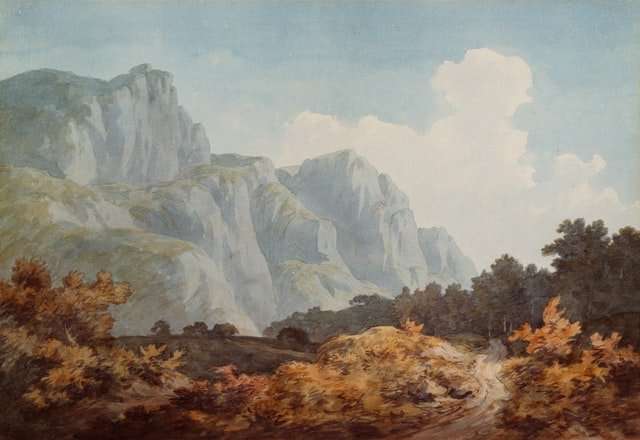I don’t know if it was the internet or just my age and lack of patience, but I’ve been reading a lot more art criticism and art history than when I was younger. I think it is important to understand what other people are doing and have done in order to do something better yourself.
Now that I was looking for it, I found an interesting blog by Kyle Christofferson titled Kyle’s Kritique of Recent Exhibits: A blog about artists and their techniques along with a little history.
The new post on John McLaughlin is fascinating in light of the fact that he has been getting a lot of attention (and selling well) recently, both at auction and on the secondary market. The post discusses a painting that sold for $2,000 in 2009 and sold again at auction in 2011 for $25,000—a nice return on your initial investment if you were lucky enough to buy one while they were dirt cheap.
Kyle has a nice writing style that makes all his posts easy to read. He also covers topics that most people don’t talk about when talking about mid century modern artists—like brush strokes and palette choices. He breaks down paintings into their components, so rather than just saying
I have no idea who this “Kyle” guy is but he seems to be really into painting and has a passion for it. He does not seem to like the post-modernists because they are “defiling” art, yet doesn’t seem to be annoyed by the fact that many of them were trained in serious schools. He also doesn’t like the fact that modern art was created for the rich and the middle class made fun of it, but I don’t think he understands why. (I mean, who can blame them? It’s like walking into a restaurant and seeing a pile of poop on the table. What’s that supposed to be?)
I suppose that he can also be considered a snob because of his lack of understanding of the mindset of someone who doesn’t appreciate fine arts as much as he does, but I don’t think you should laugh at him for that. He is an adult and has a right to his own opinions. If people didn’t have different tastes, we wouldn’t have different things; there would just be one thing: Kyle’s taste in art.
This blog isn’t interesting if you’re not into painting or if you’re not very interested in what’s going on with styles and technique. I personally am very
The main thing that strikes me about the work of the four artists above is the rather large amount of space given over to empty white space, which to me just looks lonely and uninhabited. I’m reminded of a short story I read in my younger days about a time traveler who went back to visit the Pleistocene era. He befriends a caveman but his friend eventually leaves him for being boring and not doing anything interesting. Bouchard’s work reminds me a lot of that story. The artist has an interesting idea but it’s just too plain and uninteresting to be really engaging.
I think what would make this artist stand out is some kind of strong imagery like you see in the work of Straub, particularly in the color field pieces. The layering and the textures are really nice but they need something to give them life and contrast, otherwise they just look like a blank slate. Also, it would help if she could add more value to her works by using different techniques, instead of doing everything with acrylics on canvas.
Takahashi is also pretty one note, though I do find her paintings charming and fun to look at. Her use of bright colors is good for keeping my attention but it
There are two easy ways to tell if a new artist is any good: Find out if he or she is selling well, and find out if the artist is imitated.
A big name might not be a big influence. A big influence might not be a big name. But if an artist both sells well and is imitated by other artists, then you can be pretty sure that the artist has something right; otherwise, other artists wouldn’t be copying the style.
This is especially true in art. Artists often have only one idea—their own style or approach to their subject—and they repeat it over and over again. (As opposed to science or business, where people often have several different ideas they’re working on simultaneously.)
The first step in doing mid century modern art is finding an artist who sold well and was imitated by other artists.
I really like this one, which I found through an article at the Atlantic. The artist is David Hockney, and his paintings are a little surprising because they seem so fresh and modern while being clearly influenced by the earlier (in calendar time) mid-20th century painters like Wassily Kandinsky and Piet Mondrian. These paintings give me a good feeling about humanity and art in general: that we can create something new without losing track of what came before.
The paintings are clearly inspired by the earlier work I mentioned, but it’s not just a copy. The artist is making his own choices about how to make the images, and so they’re more interesting to look at than if he had just reproduced something done in the 1930s or 1940s. Maybe that’s why they give me such a good feeling: they show how new ideas can be made with old techniques, which is exactly what we can do with our own lives.
Modern art was not born in the twentieth century, but it’s safe to say it died there. By the 1960s what had once been an avant-garde became a joke. Artists were still making it and museums were still hanging it, but no one outside of the intelligentsia took them seriously anymore.
The death of modern art is a good thing to be reminded of because the lessons learned from its demise can be applied to other things. If you think that today’s trends won’t become tomorrow’s jokes, you’re in for a rude awakening.
What killed modern art? The same thing that kills most trends: people got tired of it, and had better things to do with their time. They became more nervous about what their friends thought of them than what some supposed expert thought about their taste and they stopped buying paintings that just looked like piles of junk to them.
“Modern art” has come to mean a joke that people who like modern art tell each other: “See? This is so different from everything else you see, and yet so real! Only an idiot would find this offensive.”
But if you’re ever in doubt about whether something is truly edgy or just pretentious, remember that it was once edgy, before everyone


